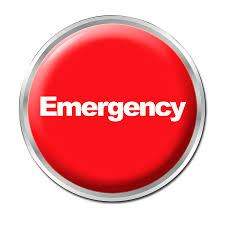Emergency! Emergency!
.jpg)
Emergency
An incident, to be an emergency, conforms to one or more of the following: if it:
Poses an immediate threat to life, health, property, or environment,has already caused loss of life, health detriments, property damage, or environmental damage,has a high probability of escalating to cause immediate danger to life, health, property, or environment.
Types of emergency
Dangers to life
Many emergencies cause an immediate danger to the life of people involved. This can range from emergencies affecting a single person, such as the entire range of medical emergencies including heart attacks, strokes, cardiac arrest and trauma, to incidents that affect large numbers of people such as natural disasters including tornadoes, hurricanes, floods, earthquakes, mudslides and outbreaks of diseases such as cholera, Ebola, and malaria.
Most agencies consider these the highest priority emergency, which follows the general school of thought that nothing is more important than human life.
Dangers to health
Some emergencies are not necessarily immediately threatening to life, but might have serious implications for the continued health and well-being of a person or persons (though a health emergency can subsequently escalate to life-threatening).
The causes of a health emergency are often very similar to the causes of an emergency threatening to life, which includes medical emergencies and natural disasters, although the range of incidents that can be categorized here is far greater than those that cause a danger to life (such as broken limbs, which do not usually cause death, but immediate intervention is required if the person is to recover properly). Many life emergencies, such as cardiac arrest, are also health emergencies.
Dangers to the environment
Some emergencies do not immediately endanger life, health or property, but do affect the natural environment and creatures living within it. Not all agencies consider this a genuine emergency, but it can have far-reaching effects on animals and the long term condition of the land. Examples would include forest fires and marine oil spills.
Systems of classifying emergencies
Agencies across the world have different systems for classifying incidents, but all of them serve to help them allocate finite resource, by prioritising between different emergencies.
The first stage of any classification is likely to define whether the incident qualifies as an emergency, and consequently if it warrants an emergency response. Some agencies may still respond to non-emergency calls, depending on their remit and availability of resource. An example of this would be a fire department responding to help retrieve a cat from a tree, where no life, health or property is immediately at risk.
Following this, many agencies assign a sub-classification to the emergency, prioritising incidents that have the most potential for risk to life, health or property (in that order). For instance, many ambulance services use a system called the Advanced Medical Priority Dispatch System (AMPDS) or a similar solution.The AMPDS categorises all calls to the ambulance service using it as either 'A' category (immediately life-threatening), 'B' Category (immediately health threatening) or 'C' category (non-emergency call that still requires a response). Some services have a fourth category, where they believe that no response is required after clinical questions are asked.
Another system for prioritizing medical calls is known as Emergency Medical Dispatch (EMD).Jurisdictions that use EMD typically assign a code of "alpha" (low priority), "bravo" (medium priority), "charlie" (requiring advanced life support), delta (high priority, requiring advanced life support) or "echo" (maximum possible priority, e.g., witnessed cardiac arrests) to each inbound request for service; these codes are then used to determine the appropriate level of response.
Other systems (especially as regards major incidents) use objective measures to direct resource. Two such systems are SAD CHALET and ETHANE, which are both mnemonics to help emergency services staff classify incidents, and direct resource.Each of these acronyms helps ascertain the number of casualties (usually including the number of dead and number of non-injured people involved), how the incident has occurred, and what emergency services are required.
The planning phase starts at preparedness, where the agencies decide how to respond to a given incident or set of circumstances. This should ideally include lines of command and control, and division of activities between agencies. This avoids potentially negative situations such as three separate agencies all starting an official emergency shelter for victims of a disaster.
Following an emergency occurring, the agencies then move to a response phase, where they execute their plans, and may end up improvising some areas of their response (due to gaps in the planning phase, which are inevitable due to the individual nature of most incidents).
Agencies may then be involved in recovery following the incident, where they assist in the clear up from the incident, or help the people involved overcome their mental trauma.
The final phase in the circle is mitigation, which involves taking steps to ensure no re-occurrence is possible, or putting additional plans in place to ensure less damage is done. This should feed back into the preparedness stage, with updated plans in place to deal with future emergencies, thus completing the circle.
.jpg)